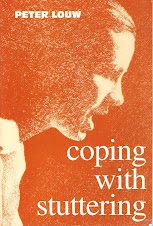Good news for people who stutter is that the American Institute for Stuttering (AIS), a leading organisation in New York offering treatment for this disorder, has joined those who believe that stuttering results from a tightening of the vocal cords.
The role of the vocal cords in stuttering has for decades been a hotly debated issue among speech experts. Though speech therapists generally accept that the vocal cords can behave unnaturally during stuttering, the traditional view has been that word and sound repetitions, prolongations and unnatural vocal-cord behaviour are all primary manifestations of this mysterious disorder.
In contrast there has been, for many decades, a dissenting line of experts who insist that an unnatural tightening, "locking" or "freezing" of the vocal cords, apparently caused by excessive tension on the cords, triggers the speech repetitions and other struggle behaviours. In other words, the internal vocal-cord spasm happens first and leads to the other, more visible symptoms.
Fundamental implications
"It appears as if there is a timing problem in the communication of signals from the brain to the speech mechanism. This 'glitch' results in a tightening or closure of the vocal cords. Because of this tightening in the throat, breathing and mouth movements become forced and laboured," according to the AIS's current website.The view that vocal-cord spasms result in stuttering has fundamental implications for stuttering treatment, as it implies that the focus of treatment should be on the vocal cords, instead of attempting to deal with the stuttering itself. If the vocal cords can be made to behave, the stutter is aborted as it depends on the cord spasm occurring.
This blog has consistently argued for years that stuttering is a conditioned reflex, resulting from a tension-related "locking" of the vocal cords. Traditional treatment aimed at the stuttering itself is misplaced as it does not address the true problem, namely the erratic, abnormal behaviour of over-tensed vocal cords. The vocal-cord muscles seem to behave this way because, when overstressed, the fine vocal-cord muscle coordination necessary for normal speech breaks down.
Reflexive attempt
A vocal-cord tightening (or "block" as it is called by people who stutter) can easily be reproduced artificially, according to the AIS website. "Take in a breath of air, keeping your mouth open, and hold your breath. Then let little puffs of air out. Feel the sensation in your throat. You just closed your vocal cords on purpose. If you stutter, this feeling will be all too familiar. Now, do that again. Hold your breath with your mouth open, don't let any air out at all and try to speak."If you don't stutter you have just created the physical sensation of what we call blocking. You know what you want to say, but imagine trying to speak and nothing comes out. Those who stutter, experience this all the time. It's as if they are choking when trying to speak.
"In a reflexive attempt to help the person speak, the mouth muscles (articulators) then kick into 'overdrive' to compensate for the vocal cords that aren't 'working'. This is the aspect of stuttering that most people see."
The AIS's view of stuttering shows that this approach to stuttering is gaining ground within therapy circles. Hopefully other speech professionals will follow their example. This is a major step toward improved and more realistic stuttering therapy.







No comments:
Post a Comment